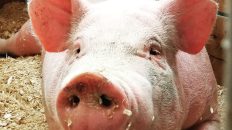I will give peace in the land, and you will sleep without fear; and I will terminate (v’hishbati) evil beasts from the land, and the sword will not pass through your domain —Leviticus 26:6
The precise meaning of the Hebrew word hashbatah, rendered here as “terminate,” is debated by our sages. According to Rabbi Judah, the term implies the utter cessation of a thing’s existence. Thus, Rabbi Judah understands the divine promise to “terminate evil beasts from the land” to mean that in the harmonious world of Moshiach all destructive creatures and forces will be “removed from the world.” Rabbi Shimon disagrees: in his opinion, hashbatah implies only the termination of a thing’s particular characteristics — in this case, the destructive nature of “evil beasts.” It is this feature of their being that G-d will eliminate, while they continue to exist in their new harmless and gainful cast. [1]
This is the root of several other debates between Rabbi Judah and Rabbi Shimon.
For example, regarding the mitzvah to destroy all leaven (chametz) in one’s possession on the day before Passover, Rabbi Judah rules that “the destruction of leaven can be acheived only by burning.”
His colleagues, however, are of the opinion that “one can also pulverise it and cast it to the wind or throw it into the sea.” [2]
Here, too, the issue is the definition of the term hashbatah, which the Torah employs in commanding us that “on the first day, you shall terminate (tashbitu) leaven from your homes.” [3]
Rabbi Judah understands this as a commandment to utterly destroy chametz, while Rabbi Shimon and the other sages hold that as long as the edibility and profitability of leaven (i.e. those aspects of its being that pertain to its prohibition on Passover) have been eliminated, one has met the requirements of hashbatah. [4]
The Future Shabbat
After citing Rabbi Judah and Rabbi Shimon’s differing interpretations of the verse “I will terminate evil beasts from the land,” the Midrash quotes the prophet Isaiah in support of Rabbi Shimon’s view: “The wolf shall dwell with the lamb, and the leopard shall lie down with the kid… An infant shall play on the cobra’s hole, and a child shall reach into the viper’s nest. They shall neither hurt nor destroy in all My holy mountain, for the earth shall br filled with the knowledge of G-d as the waters submerge the sea.” [5]
Accordingly, the messianic ideal is not a world in which everything with a negative trait or potential disappears, but one in which these traits and potentials are eliminated, and the energies that sustain them redirected to positive and G-dly ends. [6]
Rabbi Shimon’s interpretation of the verse is also consistent with the time-context in which it is read and studied as part of the annual Torah-reading cycle.
The Torah section of B’chukotai (Leviticus 26-27), which includes the divine promise to “terminate evil beasts from the land” in its opening verses, is read in the closing days of the sefirah- count, the seven-week proccess of self-refinement that leads from our annual re-experience of the Exodus on Passover to our receiving of the Torah on Shavuot.
The objective of the sefirah proccess can be seen in the difference in our attitude toward leaven on these two festivals.
On Passover, chametz is utterly rejected: we are forbiden to eat it, derive benefit from it in any way, or even keep it in our possession; there is even a special mitzvah to desroy all leaven that is in our possession on the eve of the festival.
On Shavuot, however, not only is chametz permitted, but the Torah even commands that two loaves of leavened bread be offered on the altar in the Beit Hamikdash (the Holy Temple in Jerusalem) — something that is strictly forbidden not only on Passover but all year round.
Leaven, whose primary feature is that it rises and inflates itself, represents the source of all evil in the he art of man: arrogance and pride. [7] But the sefirah-count is the proccess by which we sublimate the forty-nine adverse derivitives of pride, until we reach the point that it is divested of its negativity and can be included in the G-dly environment of the Beit Hamikdash — the environment that constituted a “taste” of a future world that shall be “wholly Shabbat and tranquility, for everlasting life.” [8]
Based on the Rebbe’s talks, Kislev 19 and 26, 5730 (November 29 and December 6, 1969) [9]
Footnotes:
[1] Torat Kohanim on verse.
[2] Talmud, Pesachim 21a.
[3] Exodus 12:15; see Talmud, Pesachim 4b-5a.
[4] Tzafenat Paaneach on Exodus, ibid.
[5] Isaiah 11:6-9.
[6] Indeed, in all the above disputes (with the exception of case of “a melachah that is not for its own sake”), we follow the opinion of Rabbi Shimon (Shulchan Aruch, Orach Chaim, 445; Tur and commentaries, Orach Chaim, 442; Shulchan Aruch, Orach Chaim, 337; Likkutei Sichot, vol. VII p. 196. See ibid., p. 191, end of note 19).
[7] See Maamar Heichaltzu 5659, sections 3 and 4.
[8] From the Shabbat addendum to Grace After Meals. For a more detailed discussion of the significance of matzah and chametz to the sefirah proccess, see Wet Matzah, WIR vol. VI no. 34.
[9] Likkutei Sichot, vol. VII p. 188-197.






Add comment